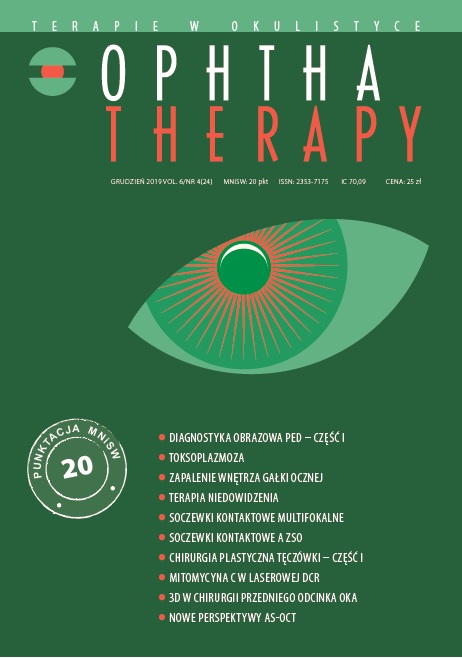The utility of three-dimensional visualization during anterior segment surgery
Main Article Content
Abstract
The heads-up surgery is becoming more and more common and acceptable as it eliminates restrictions imposed by the use of a standard microscope, and minimizes surgeon's fatigue, and allows surgery in much more natural and physiological positions of the body. It also does not affect the image quality and surgical technique. It is increasingly used not only in retinal and vitreous surgery but also in procedures preformed on the anterior segment of the eye. Preliminary observations of the results of surgical treatment of cataracts, posttraumatic changes, strabismus and bullous keratopathy with three-dimensional (3D) visualization technologies, confirmed the safety profile of treatments as compared to conventional methods. Besides, 3D imaging is distinguished by educational values and enables the performance of the light-out operation.
Downloads
Article Details

This work is licensed under a Creative Commons Attribution-NonCommercial-NoDerivatives 4.0 International License.
Copyright: ? Medical Education sp. z o.o. License allowing third parties to copy and redistribute the material in any medium or format and to remix, transform, and build upon the material, provided the original work is properly cited and states its license.
Address reprint requests to: Medical Education, Marcin Kuźma (marcin.kuzma@mededu.pl)
References
2. Dhimitri KC, McGwin G Jr, McNeal SF et al. Symptoms of musculoskeletal disorders in ophthalmologists. Am J Ophthalmol 2005; 139(1): 179-81.
3. Hyer JN, Lee RM, Chowdhury HR et al. National survey of back & neck pain amongst consultant ophthalmologists in the United Kingdom. Int Ophthalmol 2015; 35(6): 769-75.
4. Eckardt C, Paulo EB. Heads-up surgery for vitreoretinal procedures: An Experimental and Clinical Study. Retina 2016; 36(1): 137-47. https://doi.org/10.1097/IAE.0000000000000689.
5. Nowakowska D, Nowomiejska K, Rejdak R. Zastosowanie heads up surgery w chirurgii zaćmy i witrektomii. OphthaTherapy 2017; 4(2): 93-7. https://doi.org/10.24292/01.ot.300617.04.
6. Weinstock RJ, Desai N. Heads up cataract surgery with the TrueVision 3D Display System. [In] Surgical Techniques in Ophthalmology ? Cataract Surgery. Garg A, Alio JL (ed). Jaypee Medical Publishers, New Delhi, India 2010: 124-7.
7. Weinstock RJ. Operate with your head up. Cataract Refract Surg Today 2011; 8(66): 74.
8. Weinstock RJ, Diakonis VF, Schwartz AJ et al. Heads-up Cataract Surgery: Complication Rates, Surgical Duration, and Comparison With Traditional Microscopes. J Refract Surg 2019; 35(5): 318-22.
9. Qian Z, Wang H, Fan H et al. Three-dimensional digital visualization of phacoemulsification and intraocular lens implantation. Indian J Ophthalmol 2019; 67(3): 341-3.
10. Yonekawa Y. Seeing the world through 3-D glasses. Grab some pearls for the coming world of 3-D heads-up surgery. Retina Today 2016; 10: 54-60.
11. Uematsu M. Amniotic membrane transplantation with head-up surgery. [Prezentacja na: Annual Cornea Day in the 21th ESCRS Winter Meeting Maastricht 2017].
12. Mohamed YH, Uematsu M, Inoue D et al. First experience of nDSAEK with heads-up surgery: A case report. Medicine (Baltimore) 2017; 96(19): e6906.
13. Hamasaki I, Shibata K, Shimizu T et al. Lights-out Surgery for Strabismus Using a Heads-Up 3D Vision System. Acta Med Okayama 2019; 73(3): 229-33.

